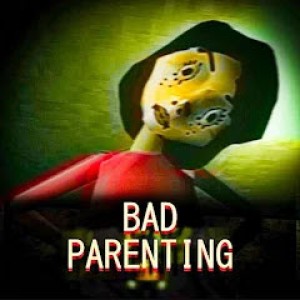
Bad Parenting review
Bad Parenting
I plunged into the world of Bad Parenting 1: Mr. Red Face with a mix of curiosity and apprehension. From the very beginning, I sensed that this game was going to challenge my preconceived ideas about what a quirky simulation could be. The title alone promised a blend of dark humor and genuine depth—attributes that soon became apparent as I navigated its unconventional narrative and mechanics. I found myself captivated by a game that was as much about the peculiar side of human nature as it was about the struggles of managing a chaotic household.
Embarking on the Chaotic Parenthood Quest
The first moments of the gameplay felt like stepping into an alternate reality where everyday family routines collided with bizarre twists. I appreciated how the game sets the tone right out of the gate, using an irreverent narrative tone paired with surprising emotional resonance. My character, Mr. Red Face, is portrayed with a delicate balance of humor and vulnerability. I felt compelled to guide him through a labyrinth of unpredictable scenarios, each moment offering both absurdity and introspection. The title’s audacity in presenting challenges that mixed realistic parenting pressures with fantastical events was truly something I had never encountered before in a simulation-style game.
Intricate Gameplay Loops and Hidden Depths
As I adapted to the gameplay mechanics, the design slowly revealed a series of intricate loops that kept me coming back for more. Every decision felt weighty, not just in terms of immediate consequences, but also in how it impacted the long-term trajectory of the character’s relationships and daily life. I was especially struck by how the game interwove a variety of mini-challenges—ranging from solving everyday mishaps to navigating surreal encounters with family members—that collectively built a rich tapestry of interactions. This was not a game that allowed for runaway simplicity; every action required thoughtful consideration and strategic planning. It placed me in scenarios where empathy mixed with pragmatism, echoing the very real dilemmas faced in actual family life.
The Multifaceted Narrative of Mr. Red Face
The narrative depth of Bad Parenting 1: Mr. Red Face is one of its strongest assets. I found the storyline to be multi-layered, featuring moments of hilarity intertwined with darker undercurrents that hinted at the complexities of modern family dynamics. The dialogue was sharp and clever, filled with surprising wit that kept me engaged through even the most challenging segments. I encountered twists that questioned the conventional ideas behind authority and responsibility, generating a reflective experience that was both thought-provoking and brutally honest. This game managed to capture the unsettling beauty of flawed familial bonds, encouraging me to reassess the stereotypes associated with an unconventional family narrative.
Innovative Mechanics and Their Impact
One of the aspects that I took great pleasure in was the game’s innovative approach to parenthood simulation. Standard mechanics were thrown out the window in favor of a dynamic system that measures emotional stress, resource management, and relationship strength. I was given the agency to tackle issues ranging from mundane conflicts at home to offbeat social dilemmas. The mechanics are designed in a way that rewards creative problem-solving; I often found that approaching a challenging situation from an off-kilter angle resulted in unexpected successes. This gameplay design not only made each playthrough a unique experience but also helped in creating an environment where risk and reward were in a constant state of balance.
Delving into the Aesthetics and Artistry
The visual design of Bad Parenting 1: Mr. Red Face was an absolute treat for my eyes. I found that the game’s aesthetic blends exaggerated cartoon-like elements with surprisingly detailed backdrops that evoke a sense of retro parenting simulations from a bygone era. The characters, while caricatured, possess a depth that makes their expressions and interactions feel authentic. I particularly admired the subtle use of color to indicate mood and emotional shifts throughout the story—the palette shifted as the narrative moved from moments of absurdity to those of genuine heartbreak or triumph. The art direction pushed me to appreciate every frame and every visual detail, no matter how small, which added a rich layer of sophistication to the overall experience.
Soundscapes and Audio Immersion
The sound design of this game deserves its own accolades. I found that every sound effect and piece of background music contributed to the immersive atmosphere of an unconventional family setting. From the quirky ambient noises of a chaotic home to the subtle undertones that underscored moments of serious reflection, the audio was perfectly calibrated to enhance the narrative. The voice acting, in particular, played a pivotal role in bringing Mr. Red Face and his family to life. I was impressed by the way each character's voice carried unique inflections and emotions, making their dialogues feel personable and deeply human. This level of detail in the soundscape underscored the game’s commitment to achieving a nuanced and memorable audio-visual experience.
User Interface and Control Complexity
Despite the game’s intricate system of mechanics, I was pleasantly surprised by the fluidity and intuitiveness of the user interface. The controls are responsive, allowing me to switch quickly between various tasks and mini-games without breaking the immersive flow. Each feature was designed with care; menus were thoughtfully organized and the learning curve was steep but surmountable. The user interface struck a fine balance between complexity and accessibility. I appreciated that even as the game threw numerous challenges at me, the underlying structure for navigation and decision-making was clear and efficient. This thoughtful design aided in mitigating the potential overwhelm that can sometimes accompany games with rich, multifaceted systems.
The Role of Humor and Satire in Gameplay
Humor is interwoven seamlessly into the fabric of Bad Parenting 1: Mr. Red Face, a characteristic that I found both entertaining and sharply insightful. I noticed that the developers infused the game with biting satire that poked fun at societal norms and the exaggerated stresses of modern family life. I laughed heartily at the outlandish scenarios that, while absurd, resonated with the underlying truth of everyday struggles. This humor was not merely gimmicky; it offered me a perspective on the often contradictory dynamics within a household. The satire elevated routine parenting dilemmas into moments of both reflective tragedy and humorous insight, ultimately enriching my overall engagement with the gameplay.
Exploration and Environment Dynamics
The expansive world of Mr. Red Face demanded exploration, inviting me to uncover hidden layers of narrative and secret subplots throughout the family household and beyond. I found that the game world was filled with interactive zones and environmental cues that enhanced the storytelling. Whether I was sifting through the clutter of a kitchen filled with personal mementos or wandering around a neighborhood that echoed with eccentric characters, every location provided a unique glimpse into the broader narrative. The exploration element felt both organic and rewarding—it was not just about following a linear storyline but about piecing together the nuances of a lived-in world that responded authentically to my actions. I cherished the moments when I discovered cleverly placed details that enriched the story in unexpected ways.
Bridging the Gap Between Simulation and Emotional Storytelling
At its core, Bad Parenting 1: Mr. Red Face is a simulation that transcends the typical boundaries of life management games. I admired how the game succeeded in merging the mundane aspects of everyday routine with profound emotional storytelling. I found that as I navigated through everyday tasks and bizarre challenges, each decision carried an emotional weight that went far beyond mere resource or time management. This emotional depth was the key to immersing me into a world where humor, frustration, and tenderness coexisted in an intricate balance. The game allowed me to experience moments of levity as well as genuine connection to characters that, despite their eccentricities, resonated with the universal struggles of maintaining relationships and personal sanity.
Evolving Character Dynamics and Family Relationships
The interplay between Mr. Red Face and his family members was a major factor that immersed me deeply into the narrative. I was drawn to the way each character was crafted with a distinct personality that mirrored real-life complexities. My interactions with these characters required me to adapt my approach to varying temperaments and hidden vulnerabilities. I experienced a spectrum of emotions as I mediated disputes, nurtured tenuous bonds, and occasionally witnessed the fallout of poor decisions in real time. This evolution in character dynamics was not static; it shifted fluidly based on choices and circumstances. I truly felt a sense of personal investment in the unfolding drama, as every interaction carried an undercurrent of meaningful consequences and introspection.
Tackling Ethical Dilemmas and Decision-Making
One of the challenges I encountered in Bad Parenting 1: Mr. Red Face was the constant presence of ethical dilemmas that forced me to weigh my options carefully. I was regularly confronted with choices that tested not only my strategic acumen but also my moral compass. Each decision was layered with implications that went beyond immediate gratification or operational efficiency and delved deep into the responsibilities of caregiving and personal integrity. The narrative mechanics rewarded thoughtful decision-making and punished hasty actions, making every choice important. I found that these ethical quandaries added a rich, psychological dimension to the gameplay, engaging me in continuous contemplation about what it means to navigate the responsibilities of caring for others, especially in an unconventional setting.
Navigating the Unpredictable World Through Adaptive Challenges
What truly set this game apart was its embrace of unpredictability. I encountered moments where the situation would change radically within seconds, requiring me to adapt quickly and rethink my strategy on the fly. Adaptive challenges kept the gameplay feeling fresh and ensured that no two experiences were exactly alike. I often found myself improvising new tactics when conventional approaches failed, which constantly pushed the boundaries of what I believed was possible within a simulation framework. These dynamic challenges not only kept my adrenaline pumping but also underscored the game’s ability to mirror the impromptu nature of real life. It was a delicate balance of strategic adaptation and chaotic spontaneity that resonated deeply with my personal approach to problem-solving.
Integrating Subtle Social Commentary and Reflective Themes
Throughout my journey as Mr. Red Face, the game wove in layers of subtle social commentary that left me pondering long after each session ended. I noticed that beneath the humor and outlandish scenarios lay a thoughtful reflection on societal expectations, generational conflicts, and the pressures faced by those cast in the role of primary caregivers. The reflective themes were interspersed throughout the game narrative in a way that encouraged me to question the very nature of authority, responsibility, and familial obligation. I appreciated how these themes were not overtly didactic but rather subtly presented through character dialogue, environmental storytelling, and cleverly designed scenarios. Every choice I made contributed to a larger commentary about balancing personal identity with the demands of a role that society often misunderstands.
Emotional Engagement Through Unpredictable Plot Twists
The narrative in Bad Parenting 1: Mr. Red Face is punctuated with plot twists that never fail to provoke an emotional response. I was often caught off guard by sudden shifts that recontextualized my previous assumptions about the characters and their motivations. This element of surprise kept me thoroughly engaged and continuously re-evaluating my strategies and decisions as events unfolded. The twists were crafted with such care that, despite their unexpected nature, they felt like organic evolutions of the narrative rather than arbitrary disruptions. I found that this unpredictability added a level of emotional intensity that made each victory all the more rewarding and each setback a poignant reminder of the stakes involved in the game.
















Leave a comment
Your comment is awaiting moderation. We save your draft here
0 Comments